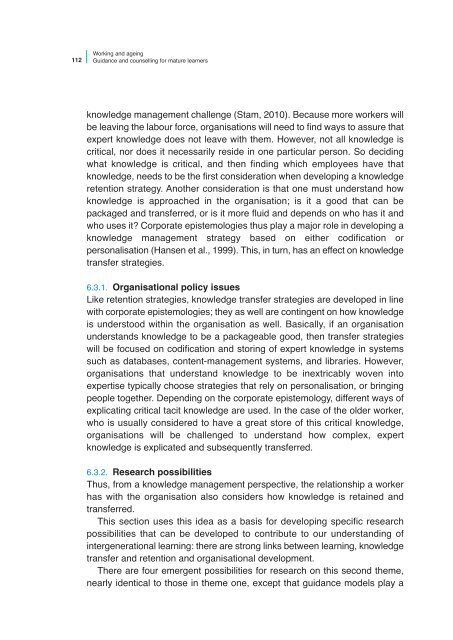Working and ageing - Cedefop - Europa
Working and ageing - Cedefop - Europa
Working and ageing - Cedefop - Europa
Create successful ePaper yourself
Turn your PDF publications into a flip-book with our unique Google optimized e-Paper software.
112<br />
<strong>Working</strong> <strong>and</strong> <strong>ageing</strong><br />
Guidance <strong>and</strong> counselling for mature learners<br />
knowledge management challenge (Stam, 2010). Because more workers will<br />
be leaving the labour force, organisations will need to find ways to assure that<br />
expert knowledge does not leave with them. However, not all knowledge is<br />
critical, nor does it necessarily reside in one particular person. So deciding<br />
what knowledge is critical, <strong>and</strong> then finding which employees have that<br />
knowledge, needs to be the first consideration when developing a knowledge<br />
retention strategy. Another consideration is that one must underst<strong>and</strong> how<br />
knowledge is approached in the organisation; is it a good that can be<br />
packaged <strong>and</strong> transferred, or is it more fluid <strong>and</strong> depends on who has it <strong>and</strong><br />
who uses it? Corporate epistemologies thus play a major role in developing a<br />
knowledge management strategy based on either codification or<br />
personalisation (Hansen et al., 1999). This, in turn, has an effect on knowledge<br />
transfer strategies.<br />
6.3.1. Organisational policy issues<br />
Like retention strategies, knowledge transfer strategies are developed in line<br />
with corporate epistemologies; they as well are contingent on how knowledge<br />
is understood within the organisation as well. Basically, if an organisation<br />
underst<strong>and</strong>s knowledge to be a packageable good, then transfer strategies<br />
will be focused on codification <strong>and</strong> storing of expert knowledge in systems<br />
such as databases, content-management systems, <strong>and</strong> libraries. However,<br />
organisations that underst<strong>and</strong> knowledge to be inextricably woven into<br />
expertise typically choose strategies that rely on personalisation, or bringing<br />
people together. Depending on the corporate epistemology, different ways of<br />
explicating critical tacit knowledge are used. In the case of the older worker,<br />
who is usually considered to have a great store of this critical knowledge,<br />
organisations will be challenged to underst<strong>and</strong> how complex, expert<br />
knowledge is explicated <strong>and</strong> subsequently transferred.<br />
6.3.2. Research possibilities<br />
Thus, from a knowledge management perspective, the relationship a worker<br />
has with the organisation also considers how knowledge is retained <strong>and</strong><br />
transferred.<br />
This section uses this idea as a basis for developing specific research<br />
possibilities that can be developed to contribute to our underst<strong>and</strong>ing of<br />
intergenerational learning: there are strong links between learning, knowledge<br />
transfer <strong>and</strong> retention <strong>and</strong> organisational development.<br />
There are four emergent possibilities for research on this second theme,<br />
nearly identical to those in theme one, except that guidance models play a

















